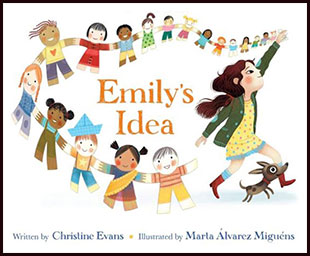Emily's Idea helps children understand how an inspiration, which may seem small-scale at the outset, can blossom into a phenomenon that transforms hearts, minds, and social interactions around the world. Emily, with some pencil-holding help from her dog, starts making paper-doll chains. Each doll is uniquely dressed, and an array of races are represented. Emily's efforts move her teacher and classmates to join in, and soon their classroom is festooned in colorful trails of paper dolls, all holding hands.
The idea continues to grow as children share with friends in other classrooms and as adults catch on. Illustrator Marta Álvarez Miguéns shows a whole page full of different grown-ups each discovering the project on their smart phone or computer and marking it with a heart or a thumbs-up. Pretty soon chains of dolls are hanging in establishments across town, and eventually they start appearing in other countries, too.
Sadly and realistically, "some people didn't understand. They ripped. Belittled. Destroyed." We see people treading on torn dolls on a sidewalk. Some merely aren't paying attention; others are going out of their way to tear apart the dolls and Emily's dream.
But nonetheless the idea continues to spread. Children will find its resilience encouraging. And in a time of vibrant movements like Black Lives Matter and Greta Thunberg's environmental activism, adults will also benefit from the reminder that dreams for a more caring world are contagious and hardy.
Meant for four to eight year olds, the book closes with instructions and a pattern for children to make their own paper-doll chain — each doll different but the same. If you're looking for ways to urge the children in your life to follow their instincts for bringing more love and unity into the world, this book belongs on your family's or classroom's shelves.
